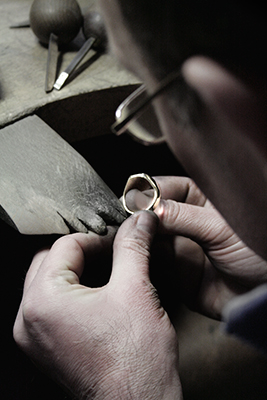
Is 9ct Actually Harder Than 18ct Gold?
The answer is probably not what you think…
As engravers we know 18ct is actually harder to engrave than 9ct gold. Pure gold is relatively malleable but importantly wants to stick to itself. The higher the proportion of gold in the alloy or ‘in the mix’, as we say in the jewellery trade, the stickier the material becomes.
There is empirical evidence to back this up: Metal hardness is measured by the Vickers Scale. The higher the score, the harder the metal. Vickers hardness of 9ct gold is between 80 to 120 (depending on the other constituents of the alloy and the condition of the material). 18ct gold receives a score of between 135 to 165.
So 18ct gold is harder than 9ct gold - science fact! As well as making the precious material stronger it is more durable against oxidisation / tarnishing and chemical corrosion.
Above: Example of a man's ring - showing the rich warm tones of 18ct yellow gold
Below: Oxford University ring, demonstrating the cooler tones of 9ct yellow gold
Where did the myth that 9ct was harder come from? Well if someone could tell me that would be great, because it appears to have no grounding in fact whatsoever. However it is easy to see why the myth became popular. We are all of course subject to market forces and the popularity of this ‘old wife’s tale’ is probably just down to cost. We know that 9ct became more popular as the gold prices began to soar after the First World War. If we are considering a purchase of gold, of course it’s nicer to believe the misconception that the lower carat ‘is more hardwearing’, rather than the truth, which is that none of us want to spend more than is absolutely necessary.
So what is the difference between 9 carat and 18 carat gold? Well the ‘gold’ in jewellery is an alloy; it is made up of pure gold (bullion) and other alloys depending on whether the finished appearance is to be yellow, white or red gold. Whichever colour you go for, 9ct is just over 1 third gold (375 parts gold), 14ct over half gold ( 585 parts gold), and 18ct is three quarters pure gold (750 parts gold).
Below: An approximation of the alloy colour: 9ct 14ct 18ct gold ring - Due to many variables from original lighting and camera settings to how your monitor / computer is balanced, depicting the exact colour is not possible How do you know what gold you have bought? Well any gold bought in the UK has been assayed (tested) and should display an official government regulated hallmark. It is a criminal offence under UK law to sell gold that is not hallmarked. Punishments for dealers selling items with no hallmark or faking hallmarks are punitive, with the latter seen as a legal equivalent to counterfeiting money.
Recognising a UK hallmark is straight forward and there is plenty of clear information on any one of the four official UK Assay Office websites. Within a hallmark you will find information on date, marker and where it was hallmarked. However as this article relates to metal purity the relevant part of the hallmark is the number stamped within an octagon (to signify gold) shape: 375 for 9ct, 585 for 14ct and 750 for 18ct. This guarantees your item of jewellery is at least that level of purity.
Left: An example hallmark (9 carat gold)
We deal with the superiority of die stamped rings and detail the manufacturing process in another article. However die stamped are by far the best, most durable signet rings available. Because of the way these rings are made they are suitable for every-day wear and they will last a life time plus, no matter what the carat. In fact your die-stamped ring will be in a fine state to pass on to future generations and should be seen as a future heirloom.
So if you choose 9ct, 14ct or 18ct the decision purely down to cost versus colour. 18 carat thought by most to have a superior colour, with its deep rich golden untarnished tones improving with age. 9ct colour is paler in hue, but of course has a more palatable price tag. 14 carat makes a lovely compromise for colour and cost between the two.
For all of us price is a major consideration. As a purchaser a more appropriate questions to ask ourselves may be; honestly what can I afford? Is it a long term investment, or a short term acquisition? Do I want something to wear all my life, or maybe I see it as a short term fashion item? To illustrate this, many of our customers are parents purchasing for their child’s 18th or 21st birthday, in most of these purchases 18ct rings are the more popular choice. Similar proportions of 18ct rings are bought for weddings and major anniversaries. While the person who makes the purchase for short term reasons maybe it signifies a club membership or they simply don’t know if they want to wear a ring forever, then the 9ct becomes a more viable proposition.
At Dexter’s we offer beautifully durable die stamped rings in 9carat, 14ct and 18 carat, to suit your budget and all your requirements. It’s important to remember that the same level of craftsmanship and care goes into both the manufacture and engraving of each and every ring no matter what the purity of gold you choose.
Right: Chief Craftsman Simon Wright checking signet ring quality




